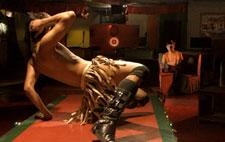Ten years young, the ImagineNative Festival has grown annually into required viewing on the festival calendar. This year is no exception as the impressive fest devoted to indigenous new media, film and video spans five days starting Wed, Oct 14 sporting several queer-friendly films.
The main queer draw this year is Boy (Oct 17, 9pm) by Kanakan Balintagos (aka Aureaus Solito) who directed the charming, award-laden feature from 2005 The Blossoming of Maximo Oliveros as well as Tuli, the ImagineNative opener for 2006.
Boy follows an unnamed 18-year-old student (Aeious Asin) in Manila who is drawn into the world of erotic “macho dancers,” namely a young man named Aries (Aries Pena). The two spend a passionate New Year’s together at the boy’s family home — despite his meddling mother — and a tender romance ensues.
While young twinks and sensual moments abound, the film may disappoint fans of Balintagos’s earlier films. Characterizations are one-dimensional and the dialogue borders on cliché. But Boy positions itself beyond standard B-movie fare as Aries’ poverty-stricken life and political arguments about the Marcos regime indicate the film is more than just eye candy. Solito also cast the actors with a degree of verisimilitude: Pena originally worked as a real-life macho dancer while Asin is a writing student at university.
Curiously, Boy was banned by government censors from screening at the Singapore International Film Festival last spring. As reported in Singapore’s Straits Times, the censors “felt that the film normalized homosexuality and that the homosexual scene was prolonged and explicit and filmed in a romanticized manner.” These people obviously haven’t seen a Bruce LaBruce film.
Boy’s love scenes are tame and not a new occurrence in the Philippines considering the long line of Filipino films portraying macho dancer culture (notably Twilight Dancers by Mel Chionglo and Macho Dancer by Lino Brocka).
Of Palaw’an descent, Balintagos also sits in on a free panel discussing the evolution of indigenous filmmaking along with Canadian luminaries Alanis Ombasawin and Zacharius Kunuk (Oct 17, 2pm).
imagineNative’s opening night film, Reel Injun, is directed by Neil Diamond (not who you’re thinking) and probes Hollywood’s ludicrous (and often campy) portrayals of Aboriginals. The seminal film does for indigenous cinema what the Celluloid Closet did for queer cinema. The doc offers a more personal take as Diamond himself drives across North America conducting personal interviews that are humourous, illuminating and hopeful (Oct 14, 7pm).
Local darling Adam Garnet Jones is back with two shorts this year. Go Get Dad follows a cute, neurotic, young man going to meet his estranged father (screening in the program Shout Out Loud Youth; Oct 15, 11am). Secondly, the gorgeously shot Wave a Red Flag is a rousing call for revolution as well as being a short for the upcoming Olympics. The film screens with the Sundance and Venice favourite Barking Water (Oct 18, 7pm).
A Decade in Retrospect (Oct 16, 3pm) is a lecture/presentation including excerpts from two queer classics. Shelly Niro’s Honey Moccasin from 1998 is a part-comedy, part-thriller, part-musical send-up of traditional notions of Aboriginal identity via the use of drag queens. Kent Monkman’s Blood River from 2000 follows an estranged brother and sister and their startling disparate lives.
Stone Bros by Richard Franklin is a pothead road trip along Australia’s outback whose casts of characters, in addition to a transvestite cousin, also include a possessed dog. An unusual comic romp, indeed (Oct 17, 7pm).

 Why you can trust Xtra
Why you can trust Xtra


